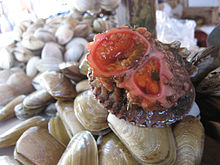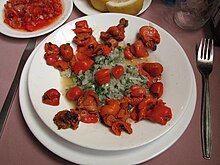| Revision as of 06:11, 10 July 2013 editSteven Walling (talk | contribs)Autopatrolled, Administrators49,794 editsNo edit summaryTag: Visual edit← Previous edit | Revision as of 06:27, 10 July 2013 edit undoSteven Walling (talk | contribs)Autopatrolled, Administrators49,794 editsNo edit summaryTag: Visual editNext edit → | ||
| Line 25: | Line 25: | ||
| They have some basic characteristics common to chordates, such as the ] and a perforated ]. It is born male, becomes hermaphroditic at puberty, and reproduces by tossing clouds of sperm and eggs into the surrounding water. If it is alone, it will self procreate. | They have some basic characteristics common to chordates, such as the ] and a perforated ]. It is born male, becomes hermaphroditic at puberty, and reproduces by tossing clouds of sperm and eggs into the surrounding water. If it is alone, it will self procreate. | ||
| On the Chilean coast, Pyura banks are heavily fished. The Pyura is also one of the main food sources of other local aquatic species such as the ] (''Concholepas concholepas''), whose reproduction has threatened and severely restricted its growth for more than two decades. | On the Chilean coast, Pyura banks are heavily fished.<ref>{{Citation|title = Over-exploitation of Pyura chilensis (Ascidiacea) in southern Chile: the urgent need to establish marine reserves|author = Andrew R. Davis|URL = http://rchn.biologiachile.cl/pdfs/1995/1/Davis_1995.pdf|journal = Revista Chilena de Historia Natural |year = 1995}}</ref> The Pyura is also one of the main food sources of other local aquatic species such as the ] (''Concholepas concholepas''), whose reproduction has threatened and severely restricted its growth for more than two decades. | ||
| == Gastronomy == | == Gastronomy == | ||
| Line 43: | Line 43: | ||
| {{reflist}} | {{reflist}} | ||
| == |
==<nowiki/>== | ||
| * blog post on the ] website | |||
| ] | ] | ||
| ] | ] | ||
Revision as of 06:27, 10 July 2013
| This article needs additional citations for verification. Please help improve this article by adding citations to reliable sources. Unsourced material may be challenged and removed. Find sources: "Pyura chilensis" – news · newspapers · books · scholar · JSTOR (July 2012) (Learn how and when to remove this message) |
| Pyura chilensis | |
|---|---|

| |
| P. chilensis harvested in the Valparaíso Region | |
| Scientific classification | |
| Kingdom: | Animalia |
| Phylum: | Chordata |
| Subphylum: | Tunicata |
| Class: | Ascidiacea |
| Order: | Pleurogona |
| Suborder: | Stolidobranchia |
| Family: | Pyuridae |
| Genus: | Pyura |
| Species: | P. chilensis |
| Binomial name | |
| Pyura chilensis (Molina, 1782) | |
Pyura chilensis is a tunicate of the family Pyuridae. It was described in 1782 by Juan Ignacio Molina.
Description
Pyura chilensis is a tunicate that resembles a mass of organs inside a rock. They often live in dense aggregations of population in the intertidal and subtidal coast of Chile and Peru. Similar in appearance to a marine rock structure, it is a filter feeder and eats by sucking in water rich in organic matter and filtering out microorganisms.
They have some basic characteristics common to chordates, such as the notochord and a perforated pharynx. It is born male, becomes hermaphroditic at puberty, and reproduces by tossing clouds of sperm and eggs into the surrounding water. If it is alone, it will self procreate.
On the Chilean coast, Pyura banks are heavily fished. The Pyura is also one of the main food sources of other local aquatic species such as the Chilean abalone (Concholepas concholepas), whose reproduction has threatened and severely restricted its growth for more than two decades.
Gastronomy

The meat, which has a strong flavour and is considered very tasty, can be prepared raw or cooked. The strong flavor is supposedly due to its high iodine content, but the taste actually corresponds to the vanadium secreted from its blood.
It is usually cut into small pieces, and flavoured with chopped onion, cilantro, and lemon. It is cooked, chopped and boiled, serving as part of many dishes, highlighting the "rice with chopped Pyura”. It can also be fried to be eaten on a piece of bread or as a complement to many dishes.
There are concerns about the safety of eating pyura, given its high concentration of vanadium. Vanadium is a heavy metal that is considered toxic at any amount more than incidental levels. The average diet provides trace amounts of vanadium; typically 6-18 micrograms (mcg). According to the University of Maryland Medical Center, vanadium can cause liver damage in high doses of 1.8 mg or more daily. No in-depth studies have been done to determine the amount of vanadium contained within the blood or tissue of pyura, nor in the typical amount of their flesh usually eaten, so they cannot be considered safe. It is known that pyura can have ten million times the amount of vanadium in their blood as there is in the surrounding seawater.
Fishery
Many locals put on their wet suit and goggles to swim the shores searching for this delicacy. Some may even travel out to sea, despite the danger of the ocean waters.
When packaged for the fish market, they are typically cut with a carpenter's saw into slices. When ready to eat, Chileans use their fingers to break away the hard shell and scoop out the insides.
References
- "WoRMS taxon details—Pyura chilensis Molina, 1782". World Register of Marine Species. Retrieved 1 July 2012.
- Andrew R. Davis (1995), "Over-exploitation of Pyura chilensis (Ascidiacea) in southern Chile: the urgent need to establish marine reserves" (PDF), Revista Chilena de Historia Natural
- ^ http://blogs.scientificamerican.com/running-ponies/2012/06/21/pyura-chilensis-the-closest-thing-to-getting-blood-from-a-stone/
- http://www.osha.gov/SLTC/healthguidelines/vanadiumpentoxidedust/recognition.html
- ^ http://www.umm.edu/altmed/articles/vanadium-000330.htm